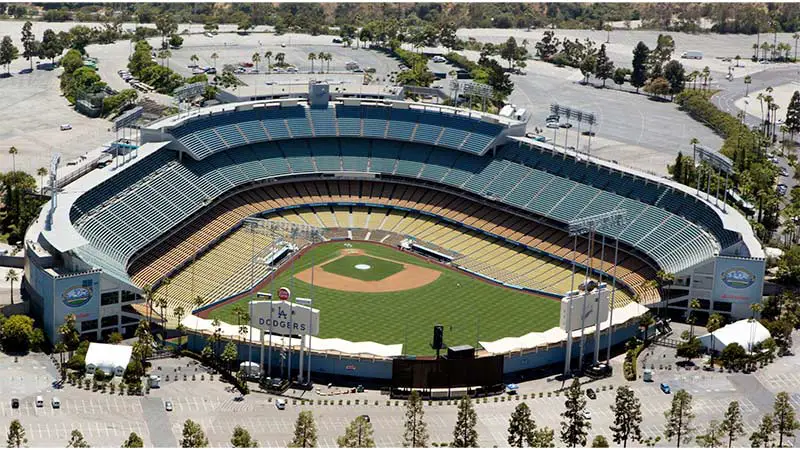When it comes to America’s favorite pastime, the size and grandeur of baseball stadiums can significantly impact the game. Among these colossal venues, a few stand out not just for their capacity but for the unique experiences they offer.
Whether you’re a die-hard fan or a casual observer, understanding the largest baseball stadiums can deepen your appreciation for the sport.
Take, for instance, the Oakland Coliseum, which boasts a baseball capacity of 47,170, making it one of the largest in the US. Built in 1966, this iconic stadium has hosted numerous memorable moments in both MLB and NFL history.
As you explore the list of the largest baseball stadiums, you’ll discover how these massive arenas shape the dynamics of the game, from home run potential to the challenges outfielders face.
Top 10 Largest MLB Stadiums by Capacity
When it comes to experiencing a Major League Baseball game, the size of the stadium can significantly enhance the atmosphere. Here are the top 10 largest MLB stadiums by capacity.
1. Dodger Stadium, Los Angeles Dodgers
Holding the title of the largest MLB stadium, Dodger Stadium boasts a seating capacity of 56,000. Opened in 1962, it’s renowned for its picturesque views of the Los Angeles landscape and has a nostalgic charm that takes you back to the golden era of baseball.
Dodger Stadium consistently draws a large crowd, often surpassing 47,000 in regular attendance.
Other notable mentions include Yankee Stadium in New York, with a capacity of 54,251, and Coors Field in Denver, which seats up to 50,144. Each of these stadiums offers a unique experience.
Yankee Stadium, opened in 2009, is known for its modern amenities and rich history, while Coors Field, home of the Colorado Rockies since 1995, offers stunning views of the Rocky Mountains.
For fans, visiting these iconic venues is more than just watching a game; it’s about being part of a legacy.
2. Yankee Stadium, New York Yankees
Yankee Stadium, with a capacity of 54,251, is a modern marvel that honors the legacy of its predecessor. Opened in 2009, it combines advanced amenities with a historical ambiance.
Despite its contemporary design, it maintains the electric atmosphere thanks to die-hard fans who fill the seats for every game. Dodger Stadium, accommodating 56,000 spectators, offers stunning views of the San Gabriel Mountains.
Opened in 1962, it remains the third oldest ballpark in Major League Baseball and continually draws huge crowds.
Another iconic venue is Fenway Park, home to the Boston Red Sox, which, despite its smaller capacity of 37,755, is rich in history and fan tradition. Opened in 1912, it is the oldest ballpark in MLB, cherished for its unique features like the Green Monster.
3. Coors Field, Colorado Rockies
Coors Field offers 50,144 seats and is famous for its mile-high altitude, which significantly impacts gameplay by boosting home runs. Opened in 1995, this stadium provides stunning views of the Rocky Mountains and is considered one of the best hitter-friendly parks in the league.
Dodger Stadium, on the other hand, is the largest by seating capacity, with 56,000 seats. Opened in 1962, it boasts a rich history and iconic status, making it a must-visit for baseball enthusiasts.
Yankee Stadium in New York, with a seating capacity of 54,251, follows closely behind. Opened in 2009, it seamlessly blends modern amenities with the rich legacy of its predecessor.
4. Chase Field, Arizona Diamondbacks
Chase Field, which opened in 1998, has a seating capacity of 48,519. It’s one of the few MLB stadiums with a retractable roof, making it a comfortable venue regardless of the weather. The park’s unique swimming pool area and modern design make it a fan favorite.
Next on the list is Dodger Stadium in Los Angeles, which holds 56,000 fans. Opened in 1962, it’s renowned for its iconic views and historic significance.
Following Dodger Stadium, Yankee Stadium in New York, rebuilt in 2009, can accommodate 54,251 spectators. Known for its rich history and state-of-the-art amenities, it offers an unparalleled experience.
5. T-Mobile Park, Seattle Mariners
With a capacity of 47,929, T-Mobile Park, which opened in 1999, offers an intimate yet expansive venue for Mariners fans. Known for its beautiful retractable roof, it ensures games are played in any weather while offering clear views of the Seattle skyline.
Another notable stadium is Dodger Stadium in Los Angeles with a capacity of 56,000. Established in 1962, it’s the oldest ballpark west of the Mississippi River, providing iconic views of the San Gabriel Mountains.
Yankee Stadium in New York, with a capacity of 54,251, is another historic venue. Opened in 2009, it replaced the original stadium while preserving the legacy of the Yankees. Its modern amenities coupled with a rich tradition make it a must-visit for any baseball enthusiast.
Fenway Park in Boston, though smaller with a capacity of 37,731, boasts the title of the oldest stadium still in use, having opened in 1912. Known for its “Green Monster,” it offers a unique and nostalgic experience.
6. Globe Life Field, Texas Rangers
Opened in 2020, Globe Life Field can seat 40,300 fans. It quickly became a prominent venue, even hosting the 2020 World Series. The stadium’s modern amenities and retractable roof provide a state-of-the-art experience for all spectators.
Another notable stadium is Dodger Stadium, located in Los Angeles, California. Opened in 1962, it has a seating capacity of 56,000, making it the largest baseball stadium by capacity in the United States.
Its picturesque views of the city and mountains, combined with a storied history, make it a must-visit for any baseball enthusiast. Next on the list is Coors Field in Denver, Colorado, renowned for its mile-high altitude and unique game-day atmosphere.
7. Oracle Park, San Francisco Giants
Oracle Park, with a capacity of 41,915, is known for its stunning view of the San Francisco Bay. Opened in 2000, it’s famous for the giant glove and Coca-Cola bottle in left field and offers a unique experience for Giants fans with its beautiful waterfront location.
Chase Field, located in Phoenix, Arizona, seats 48,519 and includes a retractable roof and swimming pool. Meanwhile, Dodger Stadium in Los Angeles can accommodate 56,000 fans, making it the largest MLB stadium.
Meanwhile, Dodger Stadium in Los Angeles can accommodate 56,000 fans, making it the largest MLB stadium. Yankee Stadium in New York, rebuilt in 2009, holds up to 54,251 spectators and features the iconic façade and Monument Park.
Finally, Coors Field in Denver, Colorado, home to the Colorado Rockies, seats 50,144 and is known for its mile-high altitude, offering a unique playing experience.
8. Citi Field, New York Mets
Home to the Mets since 2009, Citi Field can accommodate 41,922 fans. It’s designed to evoke the architectural style of Ebbets Field, offering a nostalgic feel combined with 21st-century comforts.
The Jackie Robinson Rotunda and a diverse array of food options enhance the fan experience. Another prominent stadium is Dodger Stadium in Los Angeles, which boasts a seating capacity of 56,000.
Opened in 1962, this iconic venue features picturesque views of the surrounding hills and modern amenities. Alongside these, Yankee Stadium in New York holds up to 54,251 fans, blending historical homage with modern luxury since its opening in 2009.
Each of these stadiums offers a unique experience rooted in their city’s culture and history.
9. Citizens Bank Park, Philadelphia Phillies
Opened in 2004, Citizens Bank Park seats 42,792 fans. It’s designed to maximize the spectator experience with unobstructed views from all angles. The stadium’s intimate atmosphere is complemented by features like Ashburn Alley, which celebrates Phillies legend Richie Ashburn.
Moreover, Citizens Bank Park boasts a variety of dining options, including local favorites such as Philly cheesesteaks and crab fries, enhancing the overall experience for attendees.
Additionally, the park includes numerous family-friendly amenities, making it a popular destination for fans of all ages. The combination of modern architecture and rich baseball heritage truly sets it apart.
10. Angel Stadium, Los Angeles Angels
Angel Stadium of Anaheim, with a capacity of 45,050, opened in 1966 and underwent significant renovations in the 1990s. Known for its “Big A” scoreboard and fireworks display, it remains a beloved venue for Angels fans and offers an inviting atmosphere for baseball lovers.
Rogers Centre, home to the Toronto Blue Jays, boasts a retractable roof and can hold up to 49,282 spectators. Opened in 1989, the stadium offers modern amenities and a great experience for fans.
Another notable mention is Dodger Stadium in Los Angeles. Opened in 1962, it has a seating capacity of 56,000, making it one of the largest MLB stadiums. Its scenic views and storied history make it a must-visit.
Unique Features of the Largest Stadiums
When visiting the largest MLB stadiums, you’ll notice each one brings something special to the table. From cutting-edge amenities to historical significance, these aspects enhance your experience and connect you deeper with the sport.
Amenities That Stand Out
Dodger Stadium boasts top-notch amenities, including improved seating, expanded concourses, and modernized restrooms. Yankee Stadium features Monument Park and the Yankee Museum, offering a rich baseball history experience.
Coors Field’s The Rooftop offers stunning views of the Rocky Mountains. Truist Park provides a cozy atmosphere with a variety of dining options.
Angel Stadium offers a large capacity and top-grade facilities, while Citi Field now balances gameplay for pitchers and hitters with its adaptable outfield wall.
Historical Significance and Design
Wrigley Field and Fenway Park evoke nostalgia with their historic features like Wrigley’s ivy-covered walls and Fenway’s Green Monster, offering a blend of history and present-day charm.
Dodger Stadium at Chavez Ravine remains iconic with its classic yet well-maintained design, while Minute Maid Park brings unique field dimensions and quirky elements reminiscent of older ballparks.
These stadiums’ designs and historical aspects influence gameplay and create a timeless connection for fans, making each game an unforgettable experience.
Comparing MLB Stadiums Internationally
When you think about Major League Baseball, you might automatically picture iconic American stadiums. However, baseball’s popularity spans the globe, and several impressive stadiums outside the United States showcase the sport’s international reach.
Largest Baseball Stadiums Outside of the United States
Understanding baseball’s global footprint requires a look at some of the largest stadiums beyond the U.S. borders.
Tokyo Dome, Japan
With a seating capacity of around 55,000, Tokyo Dome stands as one of the world’s prominent baseball stadiums. It’s home to the Yomiuri Giants and hosts a variety of other sports and entertainment events, making it a vibrant hub in the heart of Tokyo.
Sapporo Dome, Japan
This multi-purpose stadium in Sapporo, Japan, can hold approximately 53,796 spectators. It serves as the home field for the Nippon-Ham Fighters, offering a unique experience with its retractable surface that allows for both baseball and soccer games.
Estadio Latinoamericano, Cuba
Located in Havana, Estadio Latinoamericano boasts a seating capacity of about 55,000. Known as the largest baseball stadium in Cuba, it plays a crucial role in the country’s rich baseball history and serves as the home base for the Industriales baseball team.
Taichung Intercontinental Baseball Stadium, Taiwan
Taiwan is another baseball-loving nation with the Taichung Intercontinental Baseball Stadium, accommodating 20,000 fans. Although smaller than its Japanese counterparts, it’s significant for hosting international baseball events and fostering local talent.
Changes and Trends in Stadium Sizes
As baseball evolves, so do the stadiums where the games are played. Let’s delve into the historical and future trends in stadium sizes.
Historical Trends in Stadium Capacity
Initially, baseball stadiums were smaller and prioritized a close fan experience, with iconic early 20th-century ballparks like Fenway Park and Wrigley Field having capacities under 40,000.
By mid-century, larger stadiums like Dodger Stadium and Yankee Stadium were built to accommodate growing urban populations and increased interest in baseball, boasting capacities around 56,000.
More recent stadium developments focus on combining size with enhanced fan experiences, integrating comfortable seating, diverse dining options, and advanced technology to create more engaging environments.
Future Projections for Stadium Developments
Future stadium developments are focusing on a balanced approach between size and fan experience, integrating cutting-edge technology, sustainability, and multifunctionality.
Enhancements will include improved sightlines, luxury seating, and advanced digital features, rather than just increased capacity. Developers are prioritizing green initiatives like renewable energy, water conservation, and sustainable materials to reduce environmental impact.
Additionally, multipurpose stadiums that can host various events are becoming more popular, ensuring continuous revenue and financial viability. Overall, future stadiums aim to redefine the expectations of what a ballpark should offer.
Frequently Asked Questions
Which MLB stadiums are the biggest?
The top MLB stadiums by capacity include Dodger Stadium, Yankee Stadium, and Oakland Coliseum. These venues are known for their large seating capacities and unique features that enhance the fan experience.
Are there 33 MLB stadiums?
No, there are currently 30 stadiums used by Major League Baseball (MLB) teams.
What is the longest field in the MLB?
Coors Field, home of the Colorado Rockies, has the longest outfield wall in MLB. The center field wall is 415 feet from home plate.
Who has the smallest MLB stadium?
Tropicana Field, home of the Tampa Bay Rays, is the smallest MLB stadium by seating capacity when certain upper sections are covered with tarps.
Which MLB stadium has the highest attendance?
Dodger Stadium, home of the Los Angeles Dodgers, generally records the highest attendance in MLB, averaging more than 46,000 fans per game.
Conclusion
Exploring the largest baseball stadiums deepens your appreciation for how these iconic venues shape the game and fan experience. These arenas blend tradition and innovation to create unforgettable memories, uniting people in celebration of baseball.
Each stadium has its unique charm, architectural beauty, and storied past, with Dodger Stadium, Yankee Stadium, and the Oakland Coliseum standing out for their size and rich history.
These venues are landmarks where legacies are born and cherished, offering a grand and spirited experience of America’s pastime.
Whether you’re a die-hard fan or new to the sport, visiting these colossal arenas provides a deeper connection to the game, its history, and its community.
From the sheer capacity to the vibrant atmosphere, stadiums like Dodger Stadium in Los Angeles and Yankee Stadium in New York offer more than just a place to watch a game; they provide a place to create lifelong memories.








Pat Bloom